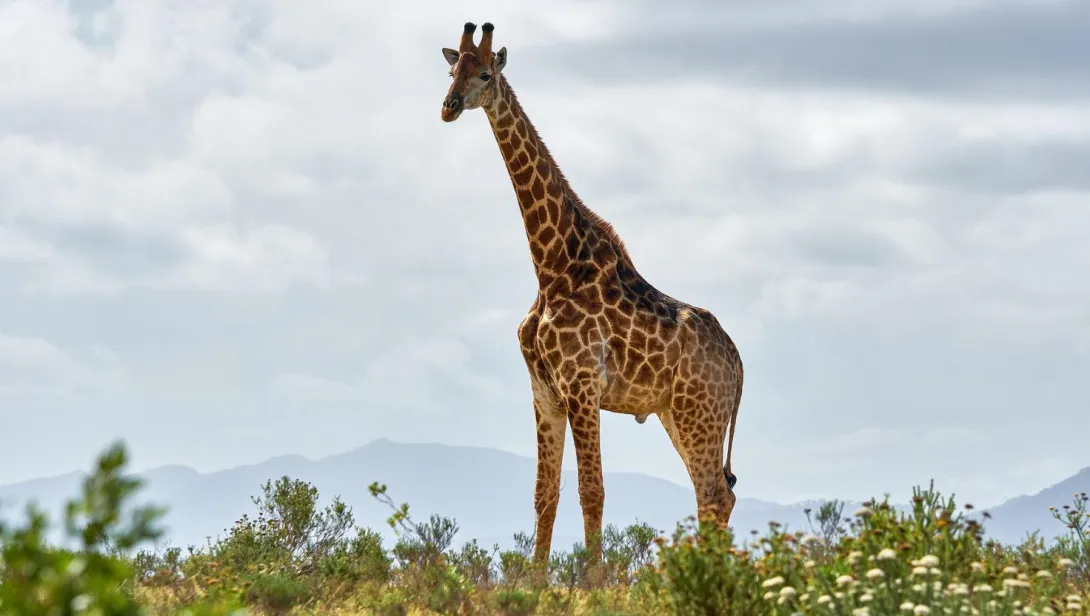Skip to main content
Introduction
- The Giraffe (Giraffa camelopardalis) is the tallest land animal on Earth.
- They are known for their long necks, long legs, and distinctive coat patterns.
- Giraffes are native to Africa and are found in savannas, grasslands, and open woodlands.
Physical Characteristics
- Giraffes have a tall, slender body, with males standing up to 18 feet (5.5 meters) tall and females slightly shorter.
- Their coat is covered in irregular patches of brown, orange, or black, separated by white lines.
- They have long necks with seven vertebrae, the same number as most mammals, but each vertebra is elongated.
- Giraffes have long legs and large hooves, which help them navigate their environment.
Habitat and Distribution
- Giraffes are found in sub-Saharan Africa, including countries like Kenya, Tanzania, and South Africa.
- They inhabit savannas, grasslands, and open woodlands, where they can find ample food and water.
- Giraffes are nomadic, covering large territories in search of food and water.
Diet and Foraging
- Giraffes are herbivorous and primarily feed on leaves, flowers, and fruits from trees, especially acacia trees.
- They consume up to 75 pounds (34 kg) of food daily.
- Giraffes use their long necks and prehensile tongues (up to 18 inches long) to reach high branches.
- They are browsers, feeding on leaves and shoots rather than grazing on grass.
Behavior and Communication
- Giraffes live in loose, open herds that can range from a few individuals to over 20.
- They communicate through vocalizations such as grunts, snorts, and moans, as well as through body language.
- Giraffes are generally peaceful but may engage in necking (combat using their necks) to establish dominance.
- They are diurnal, being most active during the early morning and late afternoon.
Reproduction and Lifespan
- Female Giraffes give birth to one calf after a gestation period of about 15 months.
- Calves are born weighing around 150 pounds (68 kg) and can stand within an hour of birth.
- Calves stay with their mothers for 18 to 24 months before becoming independent.
- Giraffes have a lifespan of 25 to 30 years in the wild and up to 40 years in captivity.
Conservation Status
- Giraffes are classified as Vulnerable on the IUCN Red List, with populations declining due to habitat loss and poaching.
- There are an estimated 68,000 giraffes left in the wild, down from over 140,000 in the last 30 years.
- They are threatened by habitat loss, human-wildlife conflict, and illegal hunting.
- Conservation efforts include protected areas, anti-poaching measures, and community-based conservation programs.
Unique Adaptations
- Giraffes have long necks that allow them to reach food sources unavailable to other herbivores.
- Their long legs and large hooves help them navigate their environment and defend against predators.
- Giraffes have a unique cardiovascular system with a powerful heart to pump blood up their long necks to the brain.
- They have thick, sticky saliva that protects their mouths from thorns while feeding on acacia trees.
Cultural Significance
- Giraffes are revered in many African cultures as symbols of grace, elegance, and uniqueness.
- They are featured in mythology, literature, and art across Africa and the world.
- In some cultures, Giraffes are considered spiritual guides and symbols of good fortune.
Fun Facts
- Giraffes can run at speeds of up to 35 mph (56 km/h).
- They are social animals, often seen in loose herds that change composition frequently.
- Giraffes can go without water for several days, getting most of their moisture from the leaves they eat.
- They are keystone species, playing a crucial role in maintaining ecosystem balance by pruning trees and dispersing seeds.
- Giraffes have excellent eyesight, which helps them spot predators from a distance.
- They are not true dogs but are more closely related to wolves and jackals.
Threats to Giraffes
- Habitat loss due to agriculture and urbanization is a major threat to Giraffes.
- Human-wildlife conflict often results in Giraffes being killed by farmers protecting crops.
- Poaching for their meat, hides, and tails is a significant cause of their decline.
- Climate change is altering their habitats, making it harder for them to find food and water.
Conservation Efforts
- Protected areas and wildlife reserves have been established to safeguard Giraffe habitats.
- Anti-poaching initiatives and stricter wildlife protection laws have helped reduce illegal hunting.
- Community-based conservation programs work to reduce human-wildlife conflict.
- Global awareness campaigns highlight the importance of Giraffe conservation and encourage public support.
